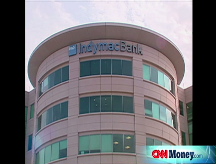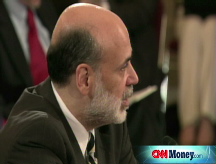Dow ends at near 2-year low
Wall Street ends volatile session mixed as slumping bank sector and Bernanke comments on the economy counter GM and oil-price tumble.
NEW YORK (CNNMoney.com) -- Stocks gave up a recovery attempt Tuesday, ending mostly lower, as falling oil prices failed to distract investors from slumping technology shares amid ongoing fears about the credit market and the economy.
The Dow Jones industrial average (INDU) lost 0.8% and closed at its lowest point since July 21, 2006. The Standard & Poor's 500 (SPX) index lost 1.1% and closed at its lowest point since Nov. 2, 2005.
The tech-heavy Nasdaq composite (COMP) gained 0.1%.
Stocks were especially volatile Tuesday, with the Dow down more than 225 points early in the session on dour economic news and more concerns about the financial market crisis.
Stocks recovered as oil prices plunged, fell as Federal Reserve Chairman Ben Bernanke testified about the economy, and then seesawed through the close in tune with the financial sector. GM's restructuring and a tech bounce were in the mix too.
"This kind of volatility is characteristic of a market that's not very strong," said Richard Stice, portfolio manager of the Dunham Large Cap Growth Fund (DNLGX).
All three major gauges were under pressure throughout the morning, with financial stocks leading the decline amid more fears about the depth of the credit market crisis. But as financial stocks recovered near midday, the rest of the market improved as well.
The tech sector got a slight boost from Intel (INTC, Fortune 500) and Microsoft (MSFT, Fortune 500), which both rose ahead of their quarterly earnings. Intel reported better-than-expected earnings and sales after the close, while Microsoft reports Thursday afternoon.
The dollar recovered a bit after slumping to a new low versus the euro. The greenback also fell against the yen. Bonds rose, lowering the corresponding yields. Oil prices plunged $6.44 a barrel, the second-worst plunge ever in dollar terms and nearly $11 off the day's high.
Financials and fuel will continue to hold control of the market going forward, said Steven Goldman, market strategist at Weeden & Co. "The stock market is quite dependent on the banking sector," he said. "It needs to see a stabilization there first."
Goldman said that the financial services stocks are vastly oversold and due for a reflex rally, with the Bank index down nearly 50% since mid-May. But at the same time, the companies need to heal before a bigger recovery can be staged - a process that could take months or years.
The Philly Bank Sector index has now slumped more than 12% in two sessions, reflecting the broad selloff in that sector.
"Investors are wondering how solvent these companies are, how much of a mess is the sector, how deep the problems run," said Stice.
Stocks remain in bear market territory after having fallen more than 20% from the cyclical highs set last October. Stice said that bear markets, on average, see the S&P 500 drop around 27% and that at the moment it is only down 22%.
Delta Air Lines (DAL, Fortune 500) and Wells Fargo (WFC, Fortune 500) both report results before the start of trade Wednesday.
Wednesday is also heavy on economic news. The Consumer Price Index (CPI) and readings on capacity utilization and industrial production are due before the start. The government's weekly oil inventories report is due around an hour after the start of trading, while the minutes from the last Fed meeting are due in the afternoon.
Financials in focus: Fannie Mae and Freddie Mac continued to tumble, one session after the news of the government's rescue plan failed to soothe investors rattled by last week's failure of mortgage lender IndyMac.
Fannie Mae (FNM, Fortune 500) lost another 27% and Freddie Mac (FRE, Fortune 500) fell 26% in a continued reaction to the government rescue plan.
On Sunday, the government announced a plan that would give the two firms, which hold or guarantee nearly $5 trillion worth of mortgages, a bigger line of credit with the Treasury and allow the Treasury to buy stock in the firms.
The plan also would allow the companies to borrow directly from the Fed, giving them the same access that commercial banks and Wall Street firms have. While the plan tempered fears that the two firms would collapse, it did little to alleviate broader worries about the economy.
Investors were also continuing to react to the failure of IndyMac, now called IndyMac Federal Bank, which was taken over by the federal government late last week. That sent National City (NCC, Fortune 500) and other regional banks lower Tuesday on worries that they could be in danger as well.
Wachovia (WB, Fortune 500) ended 7.8% lower, recovering from a bigger selloff in the morning after influential Oppenheimer & Co. analyst Meredith Whitney downgraded it to "underperform" one day after the stock ended at a 17-year low. In her note, she said that Wachovia won't be able to cut costs fast enough to counter slumping capital, and that among the major banks it will face the "greatest reckoning." (Full story)
U.S. Bancorp (USB, Fortune 500) slipped 2.7% after reporting weaker quarterly earnings and higher sales versus a year earlier. The company also said it had more than tripled its loan-loss provision, due to the continuing erosion in the housing market.
On the upside, Washington Mutual (WM, Fortune 500) bounced back 11.8% after getting hammered in the previous session on the IndyMac bandwagon.
Talk that Lehman Bros. (LEH, Fortune 500) might end up going private was lifting that stock.
State Street (STT, Fortune 500) reported higher-than-expected earnings and gave a positive outlook, sending shares of the bank up 7%.
In other earnings news, Dow component Johnson & Johnson (JNJ, Fortune 500) rose nearly 2% after reporting higher sales and earnings that topped estimates, and boosting its full-year outlook.
GM: The troubled automaker said Tuesday it will lay off salaried workers, suspend its dividend and sell off $4 billion to $7 billion of assets as a means of getting its business back on track.
The sluggish economy, rocketing fuel prices and declining interest in trucks and SUVs have hit the automaker hard over the past few years. GM (GM, Fortune 500) shares gained nearly 5%. (Full story).
Bernanke: In his semi-annual testimony before Congress, the Fed chief said that the economy is facing numerous strains resulting from the housing and financial markets, dollar weakness and surge in crude oil prices. Bernanke appeared before the Senate Banking Committee.
He also discussed the government response to Fannie Mae and Freddie Mac and the broader credit crisis.
Treasury Secretary Henry Paulson also spoke to Congress, outlining the plan to prop up Fannie Mae and Freddie Mac. (Full story)
In other news, President Bush said lawmakers should move quickly to put the legislation supporting Fannie and Freddie into play. He also urged Congress to lift its offshore drilling bans. (Full story).
Economic news: The morning brought a slew of readings on the health of the economy.
Retail sales and sales excluding volatile autos both grew less than expected in June. Both measures also grew less than they had in the previous month.
June wholesale inflation jumped 1.8%, topping economists' forecasts, the government reported, reflecting spiking fuel and food costs. However, prices excluding volatile food and energy prices rose less than expected in the month, climbing 0.2% versus forecasts for a rise of 0.3%.
Meanwhile, wholesale prices over the last 12 months have risen 9.2%, growing at the fastest pace in 27 years. (Full story)
The New York Empire State index, a closely-watched regional manufacturing report, improved in July to a reading of negative 4.9 from negative 8.7 in the previous month. Economists thought it would only improve to a reading of negative 8. Any reading that is negative shows weakness in the sector, while a positive reading shows growth.
Fuel prices rise: U.S. light crude oil for August delivery fell $6.44 to settle at $138.74 a barrel on the New York Mercantile Exchange, after having fallen more than $11 off the day's highs earlier. (Full story).
The national average price for a gallon of regular unleaded gas held steady Tuesday at an all-time high of $4.109, unchanged from the previous day, according to AAA. (Full story).
Dollar slumps: In currency trading, the dollar cut losses after it fell to a new all-time low versus the euro and also slipped against the yen, amid worries about the credit crisis and its impact on the economy.
Other markets: In global trade, European and Asian markets ended lower.
COMEX gold for August delivery rose $5 to settle at $978.70 an ounce.
In the bond market, Treasury prices rose, lowering the yield on the benchmark 10-year note to 3.83% from 3.85% late Monday. Bond prices and yields move in opposite directions. ![]()





